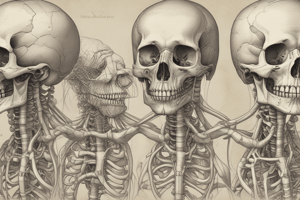Podcast
Questions and Answers
What is one of the primary functions of the thoracic wall?
What is one of the primary functions of the thoracic wall?
- Facilitating digestion
- Maintaining body temperature
- Protecting the lungs and heart (correct)
- Supporting the cranial cavity
Which of the following structures is NOT part of the thoracic wall?
Which of the following structures is NOT part of the thoracic wall?
- Ribs
- Cervical vertebrae (correct)
- Sternum
- Intercostal spaces
How many thoracic vertebrae are typically present in the human body?
How many thoracic vertebrae are typically present in the human body?
- 10
- 14
- 16
- 12 (correct)
What characterizes a typical thoracic vertebra?
What characterizes a typical thoracic vertebra?
Which of the following describes the thoracic vertebrae's articulation with ribs?
Which of the following describes the thoracic vertebrae's articulation with ribs?
Which thoracic vertebra articulates with the head of its own rib using only a single facet?
Which thoracic vertebra articulates with the head of its own rib using only a single facet?
What distinguishes true ribs from false ribs?
What distinguishes true ribs from false ribs?
What is a unique characteristic of rib I?
What is a unique characteristic of rib I?
Which of the following ribs are considered floating ribs?
Which of the following ribs are considered floating ribs?
Which is true about typical ribs?
Which is true about typical ribs?
Flashcards are hidden until you start studying
Study Notes
Thoracic Wall Overview
- Thorax is located between the neck and abdomen, separated by the diaphragm.
- Functions of thoracic walls include protecting lungs and heart and providing muscle attachment sites.
Structure of the Thoracic Wall
- Comprises sternum, costal cartilages (anterior), ribs and intercostal spaces (lateral), and vertebral column (posterior).
- Extends from superior thoracic aperture (vertebra TI, rib I, manubrium) to inferior thoracic aperture (vertebra TXII, rib XII, xiphoid process).
Skeletal Framework
- Consists of thoracic vertebrae, intervertebral discs, ribs, and sternum.
- Thoracic Vertebrae: Twelve vertebrae are characterized by articulations with ribs.
- Atypical vertebrae include T1, T9-12; typical include T2-T8.
- Typical vertebrae have heart-shaped bodies, circular foramina, and specific features for rib articulation.
Ribs
- Twelve pairs divided into true (1-7) and false ribs (8-12).
- True ribs connect directly to the sternum, false ribs connect via costal cartilages or float.
- Ribs are described as typical (3-9) and atypical (1, 2, 10-12).
- Typical ribs feature a head, neck, tubercle, and a curved shaft.
Sternum
- Adult sternum includes three parts: manubrium, body, and xiphoid process.
- Manubrium features the jugular notch and facets for clavicle and first costal cartilage.
- Body is marked by transverse ridges and articulates with costal cartilages.
- Xiphoid process varies in shape and articulates with seventh costal cartilage.
Intercostal Spaces
- Found between adjacent ribs, filled with intercostal muscles, nerves, and vessels.
- Major vessels are arranged in a specific order: vein above, artery in the middle, nerve below.
Muscles of the Thoracic Wall
- External Intercostal Muscles:
- Active during inspiration, attached to ribs, innervated by intercostal nerves.
- Internal Intercostal Muscles:
- Most active during expiration, innervated by intercostal nerves.
- Innermost Intercostal Muscles:
- Function alongside internal intercostals, with similar innervation.
- Subcostales:
- May depress ribs; innervated by related intercostal nerves.
- Transversus Thoracis:
- Depresses costal cartilages; innervated by related intercostal nerves.
Diaphragm
- A musculotendinous structure separating thoracic and abdominal cavities; important for respiration.
- Attached to xiphoid process, costal margin, lower ribs, and lumbar vertebrae.
- Innervated by phrenic nerves (C3-C5) responsible for contraction and thoracic volume increase.
Breathing Mechanics
- The thoracic wall and diaphragm work together to alter thoracic volume during breathing.
- Diaphragm movements affect vertical dimensions, while rib movements affect lateral and anteroposterior dimensions.
- Pump Handle Movement: Rib elevation shifts sternum forward.
- Bucket Handle Movement: Rib shaft elevation moves laterally.
Quick Review Questions
- Anatomy of thoracic wall components, muscle functions, rib classifications, and diaphragm roles are crucial for understanding respiratory mechanics and thoracic stability.
Studying That Suits You
Use AI to generate personalized quizzes and flashcards to suit your learning preferences.




